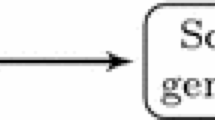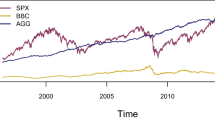Abstract
This paper investigates the concept of risk appetite. A number of methodologies for building a risk appetite index are proposed. It is shown how this index can be utilised to improve portfolio construction in currency markets. Portfolios are constructed using quadratic optimisation. Different strategies, in particular Carry, Value and Momentum, are combined via our optimisation procedure, leading to return outcomes that possess certain desirable properties relative to an equally weighted benchmark.










Similar content being viewed by others
Notes
This is a consequence of the Perron--Frobenius theorem.
The non-parametric estimate is computed using an Epanechnikov kernel with a bandwidth of 0.15 (Wand and Jones (1994))
Note: In reporting GQRI and DGQRI parameters, values have been pre-multiplied by 10,000.
Although for the purposes of this paper we only report results relating to AUD/USD and JPYNZD, results highlighting the potential explanatory power of GQRI on the conditional volatility of numerous other developed market currencies are available upon request.
These results on VIX are available on request from the authors.
More specifically, while just 1.4 per cent of respondents believe that exchange rate movements reflect changes in the fundamental value of a currency on an intra-day basis, this figure grew to 88 per cent when considering exchange rate movements over horizons greater than 6 months. This links in well to the emerging consensus that the out-of-sample performance of fundamental-based exchange rate models improves as the forecast horizon under examination increases (see, for instance, Flood and Taylor, 1996; Cheung et al., 2005).
Given the fact that the mean return of an asset is typically several orders of magnitude lower than its standard deviation, it is usually assumed that the mean return of an asset over the short-term horizon is equal to zero (see for instance Figlewski, 1997).
The results reported in Table 5 have been replicated for a variety of decay factor values and are available from the authors upon request.
See for instance JP Morgan RiskMetrics (1996).
It may also be worthwhile noting that while we have also calculated the minimum variance portfolio, the subsequent results are extremely similar to those given by the equally weighted approach to portfolio construction and are not reported here. All results are, of course, available from the authors upon request.
References
Ang, A., Chen, J. and Xing, Y. (2002) Downside Risk and the Momentum Effect. NBER Working Paper No. 8643.
Baker, M. and Jeffrey, W. (2006) Investor sentiment and the cross section of stock returns. Journal of Finance 61: 1645–1680.
Baker, M. and Stein, J. (2004) Market liquidity as a sentiment indicator. Journal of Financial Markets 7: 271–299.
Bollerslev, T., Gibson, M. and Zhou, H. (2007) Dynamic Estimation of Volatility Risk Premia and Investor Risk Aversion from Option-Implied and Realised Volatilities. CREATES Research Paper, 2007–16, University of Aarhus.
Bundesbank. Monthly Report, May 2005.
Cheung, Y-W. and Chinn, M. (2001) Currency traders and exchange rate dynamics: A survey of the US market. International Journal of Finance and Economics 9: 289–306.
Cheung, Y-W., Chinn, M. and Pascual, A. G. (2005) Empirical exchange rate models of the nineties: Are any fit to survive? Journal of International Money and Finance 24: 1150–1175.
Coudert, V. and Gex, M. (2007) Does Risk Aversion Drive Financial Crises? Testing the Predictive Power of Empirical Indicators. CEPII Discussion Paper, No. 2, January 2007.
Duan, J-C. and Yeh, C-Y. (2007) Jump and Volatility Risk Premiums Implied by VIX. mimeo (March 12 Draft), University of Toronto.
Figlewski, S. (1997) Forecasting volatility. Financial Markets, Institutions and Instruments 6: 1–88.
Flood, R. P. and Taylor, M. P. (1996) Exchange Rate Economics: What's Wrong with the Conventional Macro Approach? In: J.A. Frankel, G. Galli and A. Giovannini (eds.) The Microstructure of Foreign Exchange Markets. Chicago: University of Chicago Press, pp. 261–302.
Froot, K. A. and O’Connell, P. G. J. (2003) The Risk Tolerance of International Investors. National Bureau of Economic Research Working Paper No. 10157.
Gai, P. and Vause, N. (2006) Measuring investors’ risk appetite. International Journal of Central Banking 2: 167–188.
JP Morgan Riskmetrics (1996) Riskmetrics Technical Document, 4th edn. New York.
Kumar, M. S. and Persaud, A. (2001) Pure Contagion and Investors’ Shifting Risk Appetite: Analytical Issues and Empirical Evidence. IMF Working Paper.
Misina, M. (2003) What Does the Risk-Appetite Index Measure? (August 2003). Bank of Canada Working Paper No. 2003–23.
van Dijk, D. and Franses, P. H. (2000) Nonlinear Time Series Models in Empirical Finance. Cambridge University Press: Cambridge, UK.
Wand, M. P. and Jones, C. M. (1994) Kernel Smoothing. Chapman & Hall.
Wang, C. (2003) Investor sentiment, market timing, and futures returns. Applied Financial Economics 13: 891–898.
Acknowledgements
The authors would like to thank James Tyrrell for his helpful comments and assistance in completing this research work.
Author information
Authors and Affiliations
Corresponding author
Additional information
2received the PhD degree in Computational Finance from University of Essex (2008). His PhD degree focused on Evolutionary Computation in Financial Decision Making, with applications in statistical arbitrage and foreign exchange trading. He is currently employed as quantitative trader at Liquid Capital Management. Before this he worked in proprietary quantitative trading at Lehman Brothers, and before that as a quantitative research analyst at Old Mutual Asset Managers.
Rights and permissions
About this article
Cite this article
Luo, J., Saks, P. & Satchell, S. Implementing risk appetite in the management of currency portfolios. J Asset Manag 9, 380–397 (2009). https://doi.org/10.1057/jam.2008.40
Received:
Revised:
Published:
Issue Date:
DOI: https://doi.org/10.1057/jam.2008.40




